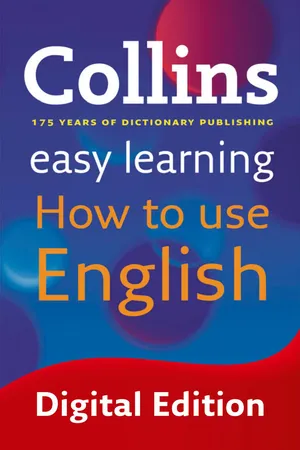
This is a test
- English
- ePUB (mobile friendly)
- Available on iOS & Android
eBook - ePub
Book details
Book preview
Table of contents
Citations
About This Book
Collins Easy Learning How to Use English is designed to help learners of all ages use individual words correctly, and choose the right words and structures for the meaning they want to convey. With its clear layout and simple explanations, this book is ideal for learners of English who want to improve their English for work, study and travel.
Frequently asked questions
At the moment all of our mobile-responsive ePub books are available to download via the app. Most of our PDFs are also available to download and we're working on making the final remaining ones downloadable now. Learn more here.
Both plans give you full access to the library and all of Perlego’s features. The only differences are the price and subscription period: With the annual plan you’ll save around 30% compared to 12 months on the monthly plan.
We are an online textbook subscription service, where you can get access to an entire online library for less than the price of a single book per month. With over 1 million books across 1000+ topics, we’ve got you covered! Learn more here.
Look out for the read-aloud symbol on your next book to see if you can listen to it. The read-aloud tool reads text aloud for you, highlighting the text as it is being read. You can pause it, speed it up and slow it down. Learn more here.
Yes, you can access Easy Learning How to Use English by in PDF and/or ePUB format, as well as other popular books in Languages & Linguistics & English Language. We have over one million books available in our catalogue for you to explore.
Information
A
a – an
You use a and an when you are talking about a person or thing for the first time. The second time you talk about the same person or thing, you use the.
She picked up a book.
The book was lying on the table.

You can describe someone or something using a or an with an adjective and a noun.
We live in an old house in the country.
When you say what someone’s job is, use a or an in front of the name of the job. For example, say ‘He is an architect’. Don’t say ‘He is architect’.
She became a lawyer.
about

You use about when you mention what someone is saying, writing, or thinking.
She told me about her job.
I need to think about that.

If you are about to do something, you are going to do it very soon.
He was about to leave.
Don’t use an ‘-ing’ form in sentences like these. Don’t say, for example, ‘He was about leaving’.

above – over

If something is higher than something else, you can use either above or over.
He opened a cupboard above the sink.
There was a mirror over the fireplace.

Above and over are both used to talk about a measurement or level of something that is higher than a particular amount.
The temperature rose to over 40 degrees.
…everybody above five feet eight inches in height.
Don’t use ‘above’ in front of a number when you are talking about a quantity or number of things or people. For example, don’t say ‘She had above thirty pairs of shoes’. Say ‘She had over thirty pairs of shoes’ or ‘She had more than thirty pairs of shoes’.
It cost over 3 million pounds.
He saw more than 800 children there.
You use over to say that a distance or period of time is longer than the one mentioned.
…a height of over twelve ...
Table of contents
- Cover
- Title Page
- Copyright
- Contents
- Introduction
- Guide to Entries
- Grammatical Terms
- How to Use English A-Z
- Topics